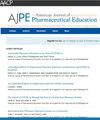测试极限:重新审视药学教育中的标准化测试。
IF 3.5
4区 教育学
Q1 EDUCATION, SCIENTIFIC DISCIPLINES
引用次数: 0
摘要
长期以来,标准化考试一直是高等教育招生中评估学术准备和预测学生成功的工具。药学院入学考试(PCAT)成立于1974年,历史上在评估未来的药学学生方面起着至关重要的作用。研究一致认为,药学专业的PCAT分数越高,学习成绩越好。然而,对标准化考试的批评,比如对一些学生(包括代表性不足的学生和低收入家庭的学生)的偏见,促使许多机构转向了不参加考试的政策。2019冠状病毒病大流行,加上申请人数的下降,加速了这一趋势,导致许多药学院采用了pcat非强制录取政策,最终导致该考试于2024年1月正式退出。这种范式转变提出了一个相关的问题,即在以分数膨胀、依赖远程学习和使用生成式人工智能为标志的不断发展的教育格局中,当前的招生实践是否有效。与此同时,医学和牙科等其他卫生专业继续使用标准化考试来决定录取。这篇评论探讨了在药学学校招生中停止标准化考试的影响,突出了所面临的挑战,并提出了一种新的、公正的标准化评估工具的发展,以帮助确定有能力满足药学教育和实践需求的学生。本文章由计算机程序翻译,如有差异,请以英文原文为准。
Testing the Limits: Revisiting Standardized Testing in Pharmacy Education
Standardized tests have long served as tools in higher education admissions to assess academic readiness and predict student success. The Pharmacy College Admission Test (PCAT), established in 1974, historically played a crucial role in evaluating prospective student pharmacists. Research consistently linked higher PCAT scores with stronger academic performance in pharmacy programs. However, criticisms of standardized testing, such as biases against underrepresented and low-income students, prompted a shift toward test-optional policies in many institutions. The COVID-19 pandemic, along with a declining number of applicants, accelerated this trend and led numerous pharmacy schools to adopt PCAT-optional admissions policies, ultimately resulting in the examination’s official retirement in January 2024. This paradigm shift raises pertinent questions about the efficacy of current admissions practices amidst evolving educational landscapes marked by grade inflation, reliance on remote learning, and the use of generative artificial intelligence. Concurrently, other health professions, such as medicine and dentistry, continue to use standardized tests for admissions decisions. This commentary explores the impact of discontinuing standardized tests in pharmacy school admissions, highlighting challenges faced and proposing the development of a new, unbiased standardized assessment tool to aid in identifying students equipped to meet the demands of pharmacy education and practice.
求助全文
通过发布文献求助,成功后即可免费获取论文全文。
去求助
来源期刊
CiteScore
4.30
自引率
15.20%
发文量
114
期刊介绍:
The Journal accepts unsolicited manuscripts that have not been published and are not under consideration for publication elsewhere. The Journal only considers material related to pharmaceutical education for publication. Authors must prepare manuscripts to conform to the Journal style (Author Instructions). All manuscripts are subject to peer review and approval by the editor prior to acceptance for publication. Reviewers are assigned by the editor with the advice of the editorial board as needed. Manuscripts are submitted and processed online (Submit a Manuscript) using Editorial Manager, an online manuscript tracking system that facilitates communication between the editorial office, editor, associate editors, reviewers, and authors.
After a manuscript is accepted, it is scheduled for publication in an upcoming issue of the Journal. All manuscripts are formatted and copyedited, and returned to the author for review and approval of the changes. Approximately 2 weeks prior to publication, the author receives an electronic proof of the article for final review and approval. Authors are not assessed page charges for publication.

 求助内容:
求助内容: 应助结果提醒方式:
应助结果提醒方式:


